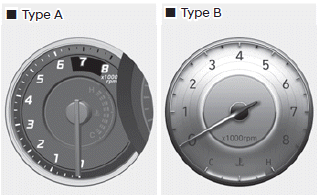Hyundai Elantra: Tire Pressure Monitoring System / Description and operation
Hyundai Elantra (CN7) 2021-2025 Service Manual / Suspension System / Tire Pressure Monitoring System / Description and operation
| Description |
The Tire Pressure Monitoring System (TPMS) monitors the pressure and temperature inside the tire in order to warn the driver of changes in pressure which may influence the operation of the vehicle. The TPMS control module analyzes wireless information fro
In other words, the system detects the pneumatic pressure of the tires and warns the driver of if the pneumatic pressure drops below the standard level.
Tire low-pressure warning light

Lamp ON/OFF Conditions when the Tire Pressure Decreases or Air is Leaking from the Tire
| 1. | Lamp ON
|
| 2. | Lamp OFF
|
TPMS Fault Warning Lamp
| 1. | Warning Conditions and Display
|
| 2. | Lamp OFF
|
System Defect
| 1. | General Operation
The following are major defects:
|
 Components and components location
Components and components location
Components1. Integrated Body Control Unit (IBU)2. TPMS sensor (FL)3. TPMS sensor (RL)4. TPMS sensor (RR)5. TPMS sensor (FR)..
Other information:
Hyundai Elantra (CN7) 2021-2025 Service Manual: Airbag Module Disposal
Description and operation Airbag Disposal When you scrap a vehicle equipped with an airbag, you must deploy it first.When you deploy an airbag, you need to have a skilled mechanic do the work. The used airbag should not be reinstalled in another vehicle for reuse. • Upon deployment, the explosion will create a loud noise, so you have to do it in a prop..
Hyundai Elantra (CN7) 2021-2025 Service Manual: Temperature Control Actuator
Description and operation DescriptionThe temperature control actuator is located at the heater unit. It regulates the temperature by the procedure as follows. The signal from the control unit adjusts the position of the temperature door by operating the temperature switch. Then the temperature will be regulated by the hot/cold air ratio decided by the position of the temperature door. Com..
Copyright © 2025 www.helantra7.com




